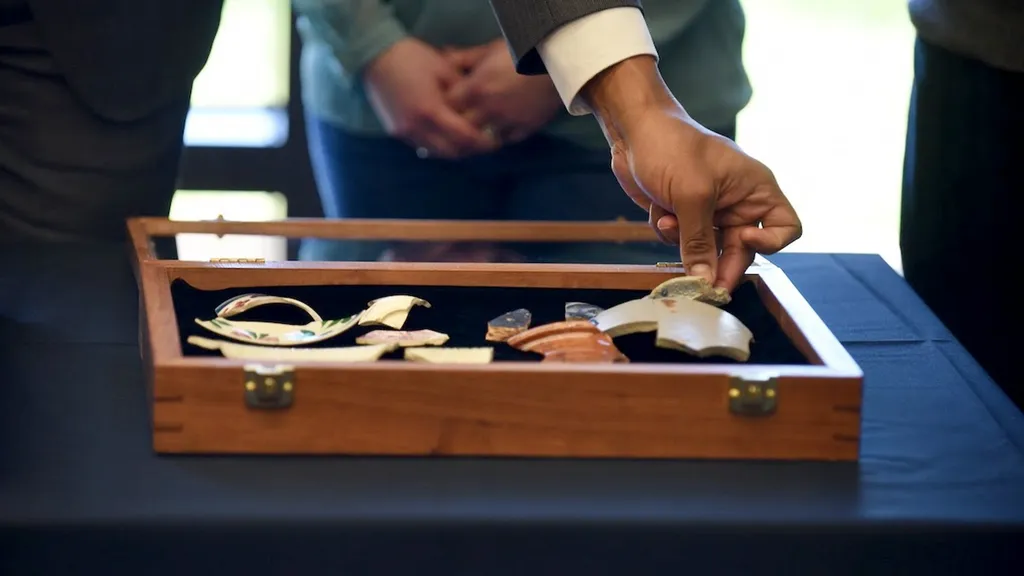- March 10, 2023
- By Rachael Grahame ’17
A clearer picture of Harriet Tubman’s early life has emerged with the discovery, led by a University of Maryland anthropologist, of a home believed to have been occupied by an enslaved overseer on the former Cambridge, Md., farm where she was born.
Julie Schablitsky, chief of cultural resources at the Maryland Department of Transportation and UMD adjunct assistant professor, and her team excavated a brick foundation from a house on private property and unearthed hundreds of artifacts. Among them was a West African spirit cache, including a glass heart-shaped bottle stopper, ceramic dish and copper alloy button, meant to protect the users from negative spirits.
Gov. Wes Moore last month announced the findings, which followed Schablitsky’s team’s discovery in March 2021 of what is thought to be the home site of Tubman’s father, Ben Ross, on what is now the Blackwater National Wildlife Refuge. Both locations were part of the Thompson Farm, where up to 40 enslaved people once lived and where the future Underground Railroad conductor and Union Army nurse and spy was born in 1822.

“We were trying to figure out who could have possibly lived in this home, because it seemed very well built and had the appearance of belonging to somebody of authority and power in that space because it had a brick foundation and a fireplace,” Schablitsky said of the new discovery. “The problem was that the artifacts spoke to a different group of people.”
Schablitsky said the artifacts included inexpensive floral-painted plates, bowls and cups in great quantities found where people were enslaved or lived in poverty. She also said that the bones they found of animals’ heads and feet didn't have a lot of meat to them and were probably thrown into soups, stews and other types of meals prepared and shared by many people. The team also found evidence that supported the enslaved community’s consumption of wild game, including racoons, muskrats, turtles, fish and oysters.
“When we started looking at other archaeological work, we noticed when you end up having this more robust structure that doesn't look like it's for enslaved families, but you have artifacts that signal someone is enslaved, it is often a place of an overseer, and in this case, based on historical research, it’s possible that the overseer who lived here is Jerry Manokey,” she said.
The team anticipates returning to the site this summer to focus on the interior of the home, and whether smaller living quarters surrounded it. Schablitsky and the team are spending some of their spring at the Brodess Farm in Bucktown, Md., about 10 miles south.
While Ben Ross, Harriet Tubman’s father, was enslaved by Anthony Thompson, her mother, Rit Green, was enslaved by Mary Brodess. Rit Green and Ben Ross met when Thompson and Brodess married around 1803 and Brodess brought her young son, Edward, and Rit Green to the Thompson property.
When Edward Brodess came of age and inherited his mother’s property, the young Harriet Tubman, her mother and her siblings were taken to the Brodess Farm.
“The family was split up when Harriet Tubman was only a few years old, so she really grew up as a child at the Brodess Farm,” said Schablitsky. “This will be the first time we're going to be trying to find Harriet Tubman’s childhood home versus her birthplace.”
The Harriet Tubman Department of Women, Gender and Sexuality Studies will hold its annual commemoration of its namesake today with “Wanted: Harriet Tubman,” a conversation with labor activist and muralist Mike Alewitz and artist and architect Nina Cooke John exploring the designs of and controversies surrounding their representations of her. Art curator and historian Adrienne L. Childs will moderate.
Ernestine “Tina” Wyatt ’95, Tubman's great-great-great grandniece, will bring greetings on behalf of her descendants to the event, which will run 4-6:30 p.m. at the David C. Driskell Center. Registration is required.
In 1849, following her self-emancipation, Tubman’s “Wanted” poster announced that should she or her brothers be found, they should be lodged in “Baltimore, Easton or Cambridge jail in Maryland.” The event’s theme, “Wanted: Harriet Tubman,” consider “wanted” as a fugitive from the law and “wanted” as a contemporary legacy and symbol.
Yesterday, Cooke John's monument to Tubman was unveiled in Newark, New Jersey, on the spot where a statue of Columbus once stood. In 2000, Alewitz’s “Dreams of Harriet,” a series of murals intended for placement throughout Baltimore, was decommissioned when a furor broke out because he had represented Tubman carrying a gun and refused to disarm her.
Topics
Research